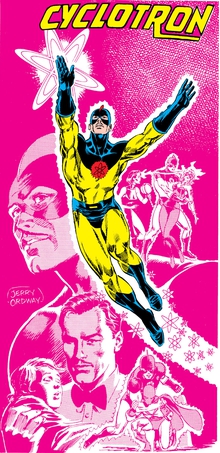
The Golden Age is a 1993 four-issue Elseworlds comic book mini-series by writer James Robinson and artist Paul Smith. It concerns the Golden Age DC Comics superheroes entering the 1950s and facing the advent of McCarthyism.

Ultra-Humanite is a supervillain appearing in American comic books published by DC Comics. He first appeared as a recurring adversary of Superman, and was among the first villains faced by him. He was designed to be the polar opposite of Superman; while Superman is a hero with superhuman strength, Ultra-Humanite is a criminal mastermind who has a crippled body but a highly advanced intellect. The Ultra-Humanite served as Superman's nemesis until Alexei Luthor and his Silver Age counterpart Lex Luthor were introduced in the comics. The origins of the super-criminal known as the Ultra-Humanite are shrouded in mystery. Even he claims not to remember his true name or appearance and attributes his vast intellect and mental prowess to scientific experiments of an unknown nature.

Amazing-Man is the name used by four fictional characters published by DC Comics. The first three are African-American superheroes and are members of the same family. The first Amazing-Man debuted in All-Star Squadron #23, and was created by Roy Thomas and Jerry Ordway. The second Amazing-Man debuted in Justice League America #86, and was created by Dan Vado and Marc Campos. The third Amazing-Man debuted in Justice Society of America vol. 3 #12, and was created by Geoff Johns and Dale Eaglesham. The fourth Amazing Man debuted in OMAC vol. 3 #2, and was created by Dan DiDio and Keith Giffen.
Miss America is a superheroine from the DC Comics Universe. She was first created by Quality Comics in Military Comics #1, and was carried over to DC Comics when they purchased Quality in the 1950s. While the original Golden Age character is in public domain, the subsequent versions created by DC Comics are not.

The Brain is a supervillain appearing in American comic books published by DC Comics. Commonly as a frequent enemy of the Doom Patrol and the Teen Titans, he is a French genius and criminal mastermind.

Icicle is the name of two supervillains appearing in comic books published by DC Comics: Joar Mahkent and Cameron Mahkent.

Per Degaton is a supervillain appearing in American comic books published by DC Comics. He is a known time-traveling villain who is a recurring enemy of the Justice Society of America.

Frankenstein is a fictional character appearing in American comic books published by DC Comics. He is based on the Frankenstein's monster character created by Mary Shelley.

Captain Triumph is a superhero from the Golden Age of Comics who first appeared in Crack Comics #27, published in January 1943 by Quality Comics. He continued to appear until the end of the series with issue #62.

Congorilla, originally a human character known as Congo Bill, is a superhero appearing in comic books published by DC Comics and Vertigo Comics. Originally co-created by writer Whitney Ellsworth and artist George Papp, he was later transformed into Congorilla by Robert Bernstein and Howard Sherman. The character first appeared in More Fun Comics #56.

The Creature Commandos are a fictional DC Comics team of military superhumans originally set in World War II. The original team was introduced in Weird War Tales #93, created by J. M. DeMatteis and Pat Broderick. The team was composed of a human team leader, a werewolf, a vampire, Frankenstein's monster, and a gorgon.

The G.I. Robot is the name of a series of six fictional robots that appeared in comic books published by DC Comics. The first four G.I. Robot characters were all created by writer Robert Kanigher, though each was designed by a different artist. Each incarnation of the G.I. Robot is an android of advanced, experimental technology designed to carry out combat and rescue missions. Multiple versions of the G.I. Robot seem to develop their own free will, as well as loyalty and a sense of friendship towards human soldiers they work alongside.

Paula Brooks is a fictional comic book character published by DC Comics. She is one of many characters to use the names Tigress and Huntress. Paula Brooks is married to Sportsmaster and the mother of Artemis Crock.

Sylvester Pemberton, alternately known as The Star-Spangled Kid and Skyman, is a superhero in the DC Comics universe. Sylvester first appeared in Star Spangled Comics #1 and was created by Jerry Siegel and Hal Sherman.

Cyclotron is the name of two different characters appearing in American comic books published by DC Comics. Though a minor character, he holds an important place in the history of the Justice Society as a source of power and inspiration for both the Atom and Atom Smasher.

Charles McNider is a fictional superhero in DC Comics. The character appeared for the first time in All-American Comics #25.
Captain Compass is a character in the DC Comics universe first appearing in 1948 in an issue of Star Spangled Comics, as a replacement for the original Robotman strip.
"The New Golden Age" is a crossover event in DC Comics publications. Written by Geoff Johns, the story follows the Justice Society of America unraveling a mystery following the Golden Age heroes and villains and the untold stories that come with it. The story comprises an eponymous one-shot and the central storyline in the ongoing Justice Society of America, as well as tie-in limited series like Stargirl: The Lost Children, Alan Scott: The Green Lantern, Jay Garrick: The Flash, and Wesley Dodds: The Sandman.















